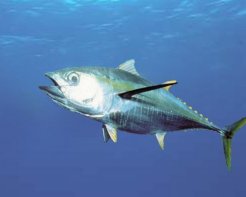
Tuna have been described as one of the largest, fastest and most wide ranging fish in the sea. They can reach more than ten feet in length and weigh weights more than 1200lbs and live for up to 40 years.
Tuna swim continuously in open water, usually often well offshore. They do not remain in one area, tending to be nomadic.
Tuna, much like the Kingfish have strong countershading. The topside of the fish is usually darker. When seen from above, the dark upper surface enables them to blend in with the deep dark blue sea below. Conversely, the underside is white of lighter in colour, allowing them to blend in with the brighter skylight above.
These fish eat many smaller fish, including squid and plankton. Fishermen sometimes use smaller tuna for bait to catch the larger adults.
Streamlining is more pronounced in fast swimmers. Tuna can swim up to seventy km. an hour. Streamlining is so important that even the eyes are flat against the body and the pectoral fins can fold down into grooves to minimise drag. The scales are tiny and smooth as well. At the front, the scales form armour like plating.
The tail is symmetrical and powerful. Strong criss-cross sinews connect the muscles to the tail. Like all big fast moving fish, they are quiet swimmers with special mechanisms to minimise drag, turbulence and pressure waves.
Please click on the links below to learn more on each of these species...
- Bigeye Tuna: (Gymnothorax prasinus)
- Yellowfin Tuna: (Thunnus albacares)
- Skipjack Tuna: ( Euthynnus pelamis )
- Albicore Tuna: ( Thunnus alalunga )
- Bluefin Tuna: ( Thunnus thynnus)
Identifying some types of tuna can be difficult, especially when yellowfin and bigeye tuna are involved. In most cases, the length of the pectoral fins can distinguish each species. The yellowfin has pectoral fins which do not extend past the anal fin; while in bigeye, the pectoral fins extend well past the anal fin.
Some Tuna tagged in American waters have sometimes been caught off Japan.